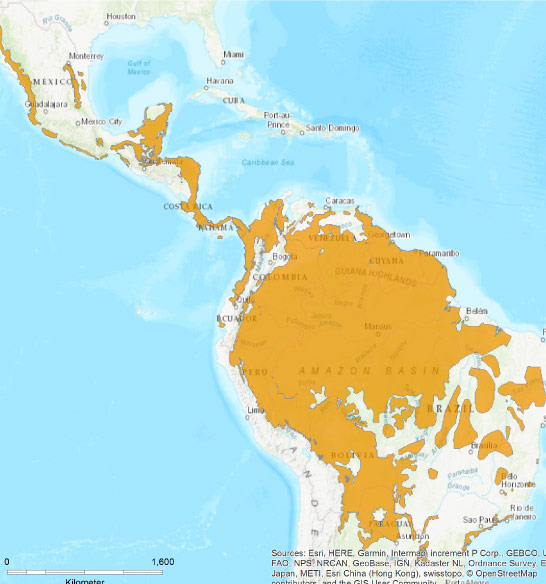Jaguar
Panthera onca
©Adriano Gambarini
Taxonomy
Standard English Name
Jaguar
Scientific Name
Panthera onca
Brazilian common name/s
Onça-pintada
Conservation status - IUCN
Physical Description
Is the largest feline in the Americas, reaching 135 kg. It is an animal with a robust frame, endowed with great muscular strength and the force of its bite is considered the largest of all felines. Another striking feature of this species is that it does not meow like most felines. Like the Lion, Tiger and Leopard, it sends a very strong series of grunts, known as a roar that can be heard for kilometres.
It has golden yellow fur with black spots on the head, neck and legs. The shoulders, back and flanks have spots forming rosettes that have, inside, one or more dots. The Leopard (Panthera pardus), which occurs in Asia and Africa, also has rosettes, but without the black dots inside. Individuals may also be found that are entirely black, which is just a melanic characteristic not a different species. Even in these melanic individuals, the spots can be viewed under oblique light.
Ecology and Habitat
Originally the distribution of jaguars went from south-western United States to northern Argentina. Now jaguars are officially extinct in the United States, and very rare in Mexico, but can still be found in Latin America, including Brazil. In general, however, their populations have declined where the species comes into conflict with human activities. In Brazil it has virtually disappeared from most parts of the northeast, south and southeast.
It occurs in several types of habitat, from forests like the Amazon and Atlantic forest, to open environments such as the Pantanal and the Cerrado. They are solitary animals, with increased activity at dusk and at night. They are territorial, occupying, depending on the type of habitat, 22 to over 150 km2, and the territory of a male may often overlap two or more females.
Their natural prey consists of wild animals such as white-lipped and collared peccaries, capybaras, deer, armadillos and even crocodiles. However when the numbers of natural prey decrease, usually as a result of changes caused by man, jaguars may turn to feed on domestic animals and are therefore persecuted.
Males and females only come together during the reproductive period. Gestation is 93 to 105 days, with a litter of only one or two cubs. The mother takes care of the cubs until they are approximately two years old. During this period, she teaches the young how to hunt and survive.
Threats and Conservation
The destruction of habitat coupled with poaching mainly as a result of the alleged economic harm caused by predation on domestic livestock has resulted in severe population declines. It is classified by the IUCN (International Union for Conservation of Nature) and by IBAMA as vulnerable and is on Appendix I of CITES.
Online links
IUCN redlist (http://www.iucnredlist.org) presents a synthesis of current knowledge about distribution and conservation status.
IUCN Cat Specialist Group:
http://www.catsg.org/catsgportal/20_catsg-website/home/index_en.htm
IUCN Cat Specialist Group species accounts:
http://www.catsg.org/catsgportal/cat-website/20_cat-website/home/index_en.htm
References
Azevedo, F. C. C. (2008). Food habits and livestock depredation of sympatric jaguars and pumas in the Iguacu National Park area, south Brazil. Biotropica, 40, 494-500.
Azevedo, F. C. C., & Murray, D. L. (2007). Evaluation of potential factors predisposing livestock to predation by jaguars. The Journal of Wildlife Management, 71, 2379-2386.
Cavalcanti, S. M. C., & Gese, E. M. (2009). Spatial ecology and social interactions of jaguars (Panthera onca) in the southern Pantanal, Brazil. Journal of Mammalogy, 90, 935-945.
Cavalcanti, S. M. C., & Gese, E. M. (2010). Kill rates and predation patterns of jaguars (Panthera onca) in the southern Pantanal, Brazil. Journal of Mammalogy, 91, 722–736 .
Dalponte, J. C. (2002). Dieta del Jaguar y Depredación de Ganado en el Norte del Pantanal, Brasil. In R. Medellín, C. L. B. Equihua, C. B. Chetkiewicz, P. G. Crawshaw Jr, A. Rabinowitz, K. H. Redford, J. G. Robinson, E. W. Sanderson & A. B. Taber (Eds.), El jaguar en el nuevo milenio (pp. 201-214). Mexico: Fondo de Cultura Económica/Universidad Nacional Autónoma de México/Wildlife Conservation Society.
Michalski, F., & Peres, C. A. (2005). Anthropogenic determinants of primate and carnivore local extinctions in a fragmented forest landscape of southern Amazonia. Biological Conservation, 124, 383-396.
Michalski, F., Boulhosa, R. L. P., Faria, A., & Peres, C. A. (2006). Human-wildlife conflicts in a fragmented Amazonian forest landscape: determinants of large felid depredation on livestock. Animal Conservation, 9, 179-188.
Romero-Muñoz, A., Maffei, L., Cuéllar, E., & Noss, A. J. (2010). Temporal separation between jaguar and puma in the dry forests of southern Bolivia. Journal of Tropical Ecology, 26, 303-311.
Sanderson, E. W., Redford, K. H., Chetkiewicz, C. L. B., Medellin, R. A., Rabinowitz, A. R., Robinson, J. G., & Taber, A. B. (2002). Planning to save a species: the jaguar as a model. Conservation Biology, 16, 58-72.
Seymour, K. L. (1989). Panthera onca. Mammalian Species, 340, 1-9.
Silveira, L., Boulhosa, R., Astete, S., & Jácomo, A. T. A. (2008). Management of domestic livestock predation by jaguars in Brazil. CAT News. Special Issue The jaguar in Brazil, , 26-30.
Torres, N. M., De Marco Jr, P., Filho, J. A. F. D., & Silveira, L. (2008). Jaguar Distribution in Brazil: Past, Present and Future. Cat News, 4, 4-8.
